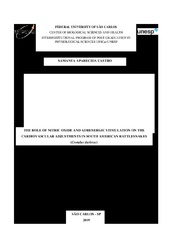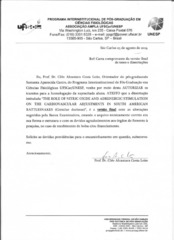| dc.contributor.author | Castro, Samanta Aparecida | |
| dc.date.accessioned | 2019-09-10T19:14:25Z | |
| dc.date.available | 2019-09-10T19:14:25Z | |
| dc.date.issued | 2019-05-24 | |
| dc.identifier.citation | CASTRO, Samanta Aparecida. The role of nitric oxide and adrenergic stimulation on the cardiovascular adjustments in South American rattlesnakes (Crotalus durissus). 2019. Dissertação (Mestrado em Ciências Fisiológicas) – Universidade Federal de São Carlos, São Carlos, 2019. Disponível em: https://repositorio.ufscar.br/handle/ufscar/11818. | * |
| dc.identifier.uri | https://repositorio.ufscar.br/handle/ufscar/11818 | |
| dc.description.abstract | Understanding the basis of vascular tone regulation is important to comprehend the cardiovascular physiology of any vertebrate. Recent investigations on reptiles have tried that description working on anesthetized animals. Unfortunatelly, such approach can be ineffective to access mechanisms that rely on some level of autonomic modulation. The aim of this study was to investigate the role of nitric oxide (NO) and of adrenergic stimulation on the control of vascular tone in reptiles. This study used the developed decerebrate rattlesnake model in order to avoid the deleterious effect of anesthetics on cardiovascular modulation. We found that NO is effective vasorelaxing in rattlesnakes and there is a resting level of NO production. Sodium nitroprusside (SNP) caused systemic vasodilation followed by systemic conductance (Gsys) and systemic flow (Q ̇sys) increasing, and it was associated with systemic mean arterial pressure (MAPsys) reduction. As a response, cardiac output (CO) was elevated. In the pulmonary circulation, SNP increased pulmonary conductance (Gpul) and reduced pulmonary mean arterial pressure (MAPpul), while pulmonary flow (Q ̇pul) remained unaffected. The systemic vasodilation after L-arginine (L-Arg) was similar to the effect of SNP injection. Although, there were no effects of L-Arg on the pulmonary circulation. Therefore, in rattlesnakes, NO is synthetized via L-Arg and it has partial role on the local regulation of systemic vascular tone. In contrast, the pulmonary vasculature is less reactive to SNP and also, NO production seems not to be dependent on the L-Arg. Adrenaline and phenylephrine caused systemic vasoconstriction that was abolished by phentolamine, demonstrating this response was mediated by α-adrenergic receptors. Injection of phentolamine caused a marked vasodilatation followed by Gsys and Q ̇sys increasing, and it was associated with MAPsys reduction. Injection of propranolol promoted bradycardia, with consequent decreasing of CO and Q ̇sys and increased of systemic vascular tone, without changing the Gsys and MAPsys. These results indicate adrenergic modulation via α-receptors is quantitativelly more relevant to modulate MAP than the β-receptors branch of barorreflex in Crotalus. Pulmonary vasculature is less responsive to adrenergic stimulation. Also, phentolamine was more effective in alter Gpul than propranolol. Therefore, we suggest that the adrenergic stimulation by the sympathetic branch of the autonomic nervous system is more effective in modulate vascular tone than cardiac activity in rattlesnakes. | eng |
| dc.description.sponsorship | Coordenação de Aperfeiçoamento de Pessoal de Nível Superior (CAPES) | por |
| dc.language.iso | eng | eng |
| dc.publisher | Universidade Federal de São Carlos | por |
| dc.rights.uri | Acesso aberto | por |
| dc.subject | Autonomic nervous system | eng |
| dc.subject | Decerebration | eng |
| dc.subject | Nitric oxide | eng |
| dc.subject | Reptiles | eng |
| dc.subject | Sympathetic activation | eng |
| dc.subject | Vascular tone | eng |
| dc.subject | Ativação simpática | por |
| dc.subject | Descerebração | por |
| dc.subject | Óxido nítrico | por |
| dc.subject | Répteis | por |
| dc.subject | Sistema nervoso autônomo | por |
| dc.subject | Tônus vascular | por |
| dc.title | The role of nitric oxide and adrenergic stimulation on the cardiovascular adjustments in South American rattlesnakes (Crotalus durissus) | eng |
| dc.title.alternative | O papel do óxido nítrico e da estimulação adrenérgica nos ajustes cardiovasculares em cascavéis sul-americanas (Crotalus durissus) | por |
| dc.type | Dissertação | por |
| dc.contributor.advisor1 | Leite, Cléo Alcantara Costa | |
| dc.contributor.advisor1Lattes | http://lattes.cnpq.br/2031764784233552 | por |
| dc.description.resumo | Entender a base da regulação do tônus vascular é importante para compreender a fisiologia cardiovascular de qualquer vertebrado. Investigações recentes em répteis tentaram essa descrição trabalhando em animais anestesiados. Infelizmente, essa abordagem pode ser ineficaz para acessar mecanismos que dependem de algum nível de modulação autonômica. O objetivo deste estudo foi investigar o papel do óxido nítrico (NO) e da estimulação adrenérgica no controle do tônus vascular em répteis. Este estudo utilizou o modelo de cascavel descerebrada desenvolvido para evitar o efeito deletério dos anestésicos na modulação cardiovascular. Descobrimos que o NO é um vasorelaxante eficaz em cascavéis e existe um nível de repouso na produção de NO. O nitroprussiato de sódio (SNP) causou vasodilatação sistêmica, seguida por aumento da condutância sistêmica (Gsys) e fluxo sistêmico (Q ̇sys), e esse resultado foi associado à redução da pressão arterial média sistêmica (PAMsys). Como resposta, o débito cardíaco (DC) foi elevado. Na circulação pulmonar, o SNP aumentou a condutância pulmonar (Gpul) e reduziu a pressão arterial média pulmonar (PAMpul), enquanto o fluxo pulmonar (Q ̇pul) permaneceu inalterado. A vasodilatação sistêmica após a L-arginina (L-Arg) foi semelhante ao efeito da injeção de SNP. Embora não houvesse efeitos da L-Arg na circulação pulmonar. Portanto, em cascavéis, o NO é sintetizado via L-Arg e tem papel parcial na regulação local do tônus vascular sistêmico. Em contraste, a vasculatura pulmonar é menos reativa ao SNP e a produção de NO parece não depender da L-Arg. Adrenalina e fenilefrina causaram vasoconstrição sistêmica que foi abolida pela fentolamina, demonstrando que esta resposta foi mediada por receptores α-adrenérgicos. A injeção de fentolamina causou uma acentuada vasodilatação, seguida de aumento da Gsys e Q ̇sys, e esteve efeito foi associado à redução da PAMsys. A injeção de propranolol promoveu bradicardia, com consequente diminuição do DC e Q ̇sys, e aumento do tônus vascular sistêmico, sem alteração da Gsys e PAMsys. Esses resultados indicam que a modulação adrenérgica, via α-receptores, é quantitativamente mais relevante do que o ramo β-receptor do barorreflexo, para modular a PAM em Crotalus. A vasculatura pulmonar é menos responsiva à estimulação adrenérgica. Além disso, a fentolamina foi mais eficaz do que propranolol em alterar a Gpul. Portanto, sugerimos que a estimulação adrenérgica, pelo ramo simpático do sistema nervoso autônomo, é mais eficaz do que a atividade cardíaca, em modular o tônus vascular em cascavéis. | por |
| dc.publisher.initials | UFSCar | por |
| dc.publisher.program | Programa Interinstitucional de Pós-Graduação em Ciências Fisiológicas - PIPGCF | por |
| dc.subject.cnpq | CIENCIAS BIOLOGICAS::FISIOLOGIA | por |
| dc.subject.cnpq | CIENCIAS BIOLOGICAS::FISIOLOGIA::FISIOLOGIA DE ORGAOS E SISTEMAS::FISIOLOGIA CARDIOVASCULAR | por |
| dc.subject.cnpq | CIENCIAS BIOLOGICAS::FISIOLOGIA::FISIOLOGIA COMPARADA | por |
| dc.description.sponsorshipId | CAPES: Código de Financiamento 001 | por |
| dc.ufscar.embargo | 24 meses após a data da defesa | por |
| dc.publisher.address | Câmpus São Carlos | por |
| dc.contributor.authorlattes | http://lattes.cnpq.br/3202336955072876 | por |


